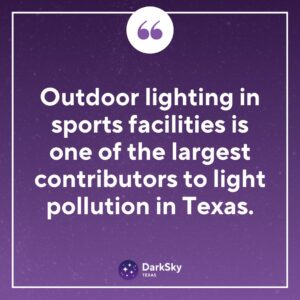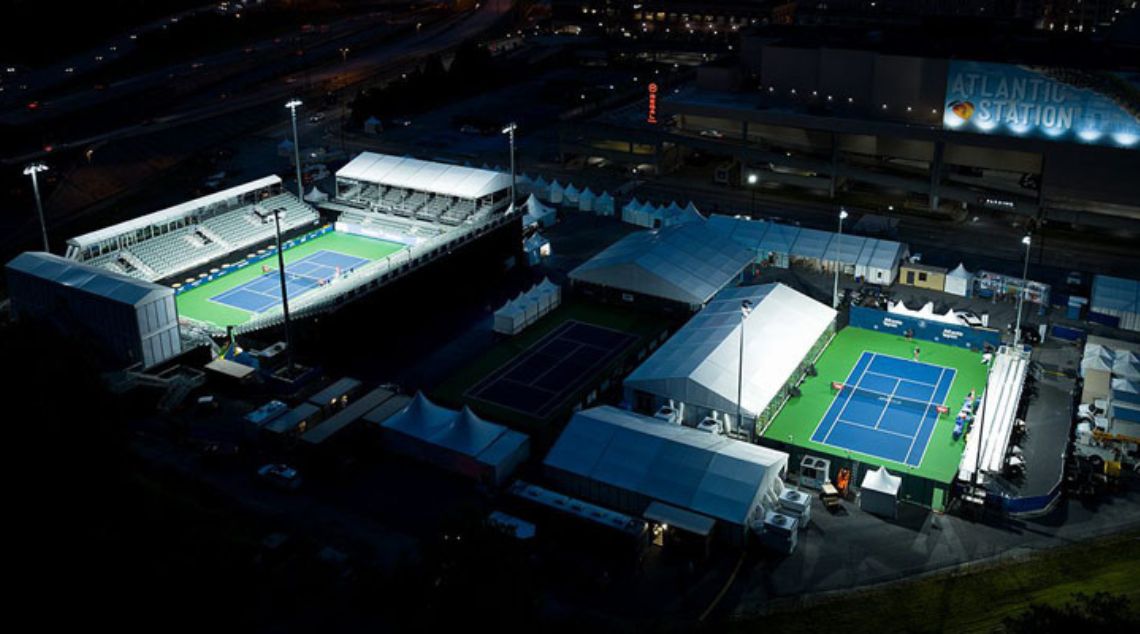When we talk about light pollution, we usually go back to one eternal conundrum: the balance between continuing to develop as a society and the efforts to reduce bright outdoor lights at night.
Outdoor sports facilities often receive criticism for this. Whether private or community-owned, they provide an essential space for entertainment and health. Our typical Texan hot weather makes it uncomfortable to use them during the day, but at night, we usually need large, reflective lights to see well.
On March 6th, 2024, DarkSky Texas hosted Brad Schlesselman for an illustrative webinar on this very topic. He walked us through many practical ways to design sports facilities without generating light trespass, extra skyglow, or glare.
Can we illuminate the sports field without blasting lights for miles? Outdoor Sports and Light Pollution: A Difficult Conundrum
Outdoor sports venues (from stadiums to neighborhood sports fields) are often mentioned first whenever light pollution is discussed.

This is because, traditionally, these spaces combine two key features: they require bright enough lights for us to track a ball across a field; at the same time, most older sports lighting designs spread excess lighting throughout and above the neighborhood. Both factors combine to create a potent source of light pollution – which is rarely shielded or contained.
As a result, sports lighting often significantly contributes to an area’s skyglow, which disrupts the local ecosystem and harms nearby wildlife. Due to its open nature, this can also create glare on surrounding roads, and spill light may affect light levels in nearby homes – and in these cases, the cost is usually measured in traffic accidents, insomnia, and even chronic headaches among residents.
And yet, these sports facilities play an important role in our lives. They promote healthier lifestyles, contribute to the local economy, and often become the beating heart of an up-and-coming neighborhood.
But it Doesn’t Have to Be This Way!
At DarkSky Texas, we believe that ingenuity and technology can help night lovers and sports fans meet halfway. To reconcile their needs – and the opposing pulls of development versus conservation – DarkSky International routinely offers expert guidance for towns, landowners, and entrepreneurs committed to minimizing light pollution.
Our interventions are all based on the Five Principles for Responsible Outdoor Lighting. These principles translate into practical design tweaks that can prevent even stadium lights from becoming disruptive.
For those wanting to see our Principles turned into action, we brought Brad Schlesselman to our latest webinar, held on March 6th, 2024. Schlesselman is a senior research engineer with over a decade of experience in lighting solutions. He is also one of the brains at Musco Lighting, one of the country’s largest companies devoted to constructing and designing sports lighting fixtures. Nowadays, he also serves as the Chair of the Discomfort Glare in Outdoor Nighttime Environments Committee of the Illuminating Engineering Society (IES).
Watch the entire session here:
Designing DarkSky Approved Outdoor Sports Lighting: What Did Brad Teach Us?
During his lecture, Brad returned to one of the earliest successes in responsible outdoor sports lighting: the design of the Sahuarita Sports Complex in Arizona. Here, Musco Lighting joined a team of city leaders and observatory personnel so that the city could have its cake and eat it too: in 2017, investors wanted to finance a new outdoor stadium in the area, but residents wanted to protect the nearby Whipple Observatory.
Eventually, the same techniques used in Sahuarita became the foundation for DarkSky International’s Approved Outdoor Sports Lighting Program, which provides one of the best real-life examples of our 5 Principles in action.


